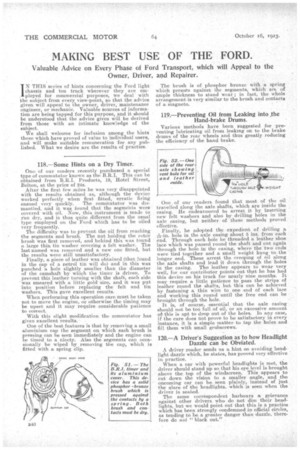MAKING BEST USE OF THE FORD.
Page 24

If you've noticed an error in this article please click here to report it so we can fix it.
Valuable Advice on Every Phase of Ford Transport, which will Appeal to the Owner, Driver, and Repairer.
IN THIS series of hints concerning the Ford light chassis and ton truck wherever they are employed for commercial purposes, we deal with the subject from every view-point, so that the advice given will appeal to the owner, driver, maintenance engineer, or mechanic. Valuable sources of information are being tapped for this purpose, and it should be understood that the advice given will be derived from those with an intimate knowledge of the subject.
We shall welcome for inclusion among the hints those which have proved of value to individual users, and will make suitable remuneration for any published. What we desire are the results of practice.
118.—Some Hints on a Dry Timer.
One, of our readers recently purchased a special type of commutator known as the BALI. This can he
obtained from Products, 19, 'HotelStreet, Bolton, at the price of 24s.
After the first few miles he was very disappointed with the results obtained as, although the device worked perfectly when first fitted, erratic firing ensued very quickly. The commutator was dismantled, sand it was found that the segments were covered with oil. Vow, this instrument is made to run dry, and is thus quite different from the usual type employed on the Ford which has to be oiled very frequently.
The difficulty was to prevent the oil from reaching the segments and brush. The nut holding the rotor brush was first removed, and behind this was found a large thin tin washer covering a felt washer_ The last named was removed and a new one fitted, but the results were still unsatisfactory.
Finally, a piece of leather was obtained (that found in the cap of a petrol tin will do) and in this was punched -a hole slightly smaller than the diameter of the camshaft by which the timer is driven. To prevent this leather turning with the shaft, each side
• was smeared with a little gold size, and it was put into position before replacing the felt and tin washers. This gave excellent results.
When performing this operation care must be taken not to move the engine, or otherwise the timing may be upset and it may require considerable patience to correet.
With this slight modification the commutator has given excellent results.
One of the best features is that by removing a small alurninitim cap the segment on which each brush is pressing can be seen immediately and the engine can be timed to a nicety. Also the segments can occasionally be wiped by removing the cap, which is fitted with a spring clip.
The brush is of phosphor bronze with a spring which presses against the segments, which art of ample thickness to stand wear ; in fact, the whole arrangement is very similar to the brush and contacts of a Magneto. • 119.—Preventing Oil from Leaking into „the Hand-brake Drums.
Various methods have been suggested for preventing lubricating oil from leaking on to the brake drums of the rear wheels and thus greatly reducing the efficiency of the hand brake.
One, of our readers found that most of the oil travelled along the axle shafts-, which are inside the easing. He endeavoured to arrest it by inserting new felt washers and also by drilling holes in the axle casing, but neither of these methods proved effective.
Finally, he adopted the expedient of drilling a. 7:5-4--in, hole in the axle casing about 5 ins, from each end. Through each hole he threaded a leather shoe lace which was passed round the shaft and out again through the hole in the casing, where the two ends were tied together and a small weight hung to the longer end. These arrest the creeping of oil along the axle shafts and lead it down through the holes in the casing. The leather appears to wear very well, for our contributor points out that he has had this device on his truck for nearly nine months. It may require a, little patience to pass the strips of leather round the shafts, but this can be achieved by fastening a thin wire to one end of each lace and working this round until the free end can be brought through the hole. It is, of course, essential that the axle casing should not be too full of oil, or an excessive amount a this is apt to drop out of the holes. In any case, if the cure does not prove to be satisfactory in every instance, it is a simple matter to tap the holes and fill them with small grubscrews.
120.—A Driver's Suggestion as to how Headlight Dazzle can be Obviated.
A driver reader sends us a. hint on avoiding headlight dazzle which, he states, has proved very effective in practice.
When a car with powerful headlights is met, the driver should stand up so that his eye level is brought above the top of the windscreen. This appears to cut down the vision to a smaller angle and the oncoming car can be seen plainly, instead of just the glare of the headlights, which is seen when the driver is seated.
The same correspondent harbours a grievance against other drivers who do not dim their headlights, but we would point out that this is a practice which has been strongly condemned in official circles, as tending to be a greater danger than dazzle, therefore do not "black out."
































